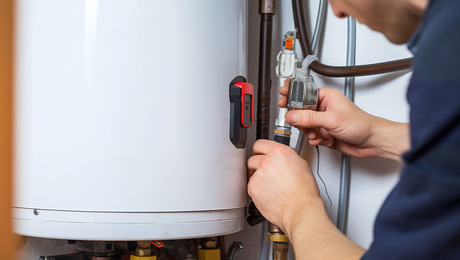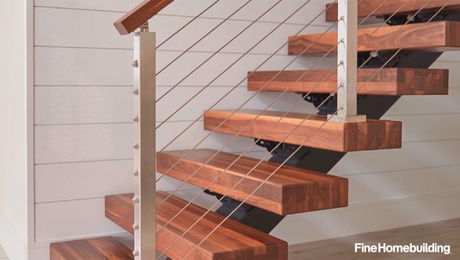I am considering replacing an old baseboard water heating system with an electric radiant system in two rooms, one 10 x 14 and one 10 x 20. Substrate is plywood,, and I plan to put ceramic tile over the electric radiant. I have no experience with Radiant heat — anything I should watch out for?
Discussion Forum
Discussion Forum
Up Next
Video Shorts
Featured Story

Learn more about the benefits and compliance details for the DOE's new water heater energy-efficiency standards.
Featured Video
Builder’s Advocate: An Interview With ViewrailHighlights
"I have learned so much thanks to the searchable articles on the FHB website. I can confidently say that I expect to be a life-long subscriber." - M.K.

















Replies
Sharp screw heads not countersunk enough.
Seriously, do check the grid before you thinset over it. 'Warmly yours' brand includes a continuity tester/alarm that you wire up temporarily while installing. If there is a break the alarm will sound. It is much easier to repair it before the tile goes down.
http://www.suntouch.net/
Consider 240V matts instead of 120V.
would the higher wattage be needed for larger area coverage -- or is that a factor?
Allows you to run fewer circuits and it will heat up faster.
What you say is incorrect. A watt is a watt, whether supplied by120 volts or 240 volts. For the same wattage (and for a given size they WILL be the same wattage) the 240v floor matt will NEVER heat up faster.
OTH, electric floor mats have, on average, 10 w/sf. In a 10x20, (the heated area should be no more than 9x18) that is 1620 watts, in a 120v circuit that 13.5 amps, easily handled with a single 20 amp circuit.
I just installed just shy of 200sqft of the Warm Tile system and it worked great.
http://www.warmtiles.com/ I had looked at some of the mat systems at the big orange box and they did not very practical for my installation because of the shape of the room and vents and other considerations.
I installed cement backerboard in a bed of thinset first, screwing the heck out of it because the plywood was on soft side. I then installed the heating cable with a 3" spacing. between every third row I tacked down a narrow strip that of 1/4" backerboard to act as a gauge block. More thinset followed and was allowed to cure and then the marble went down like usual.
I used thinset instead of leveling compound to bed the cables because of cost, about 80% less than leveling compound.
Don't skimp on the thermostat get the programmable one, it has the ground fault already built into it and just makes sense to only heat the floor when you need it instead of 24-7.
I also went to 220 volt and ordered everything electrical over the net because Menards could not even come close on cost.
Grab your volt ohm meter and take readings from time to time just so that you know that the cable has remained undamaged. It is actually pretty durable but then again why take chances.
Now the only problem I have is the home owner will want 3 more bathrooms done the same way.
Hi,
I guess one thing to think about is that the electric radiant is likely to be more expensive to run, and generate more green house gases.
Gary
With expected shortages in supply of Natural Gas and Propane and the prices which should jump when in short supply. I would expect that Electric Radiant Floor heat should soon be the least expensive heating method available. Also US powerplants have the most highly regulated emissions of any other type of machine in the world. Per Joule of energy produced they are cleaner than any propane furnace or water heater on the market. I'm far more worried about the green house gasses produced by cars and trucks.
This article is from JLC about installation
Hi,"Also US powerplants have the most highly regulated emissions of any other type of machine in the world. Per Joule of energy produced they are cleaner than any propane furnace or water heater on the market. I'm far more worried about the green house gasses produced by cars and trucks."I'd respectfully submit that this is not true.To produce 100K BTU of heat from a coal fired power plant using electric resistance heating generates 62 lbs of Carbon Dioxide. Coal plants generate most of the electricity in the US.To produce the same 100K BTU of heat from a 90% efficient gas furnace or boiler produces 12 lbs of Carbon Dioxide.So, the electic/coal heater makes 5 times more greenhouse gas for the same amount of heat. This is because coal is a high carbon fuel, and coal fired electric plants are only about 30% efficient. Space heating is a major source of GHG -- its right up there with your car.At 10 cents per KWH, the 100K BTU costs $2.92, so gas would have to go up to ($2.93)(0.9) = $2.63 per therm to cost the same as electricity. As controls on carbon emissions come in over the next 10 years or so, electricity produced from coal is going to go up substantially (I think).Carbon calculator here:
http://www.infinitepower.org/calculators.htmGary
http://www.BuildItSolar.com
I'd make sure you check the spec on this. It sounds like you're using this to actually heat the room. Not sure if the 220 puts out significantly more heat than the 120 but I don't think there is any way these mats will heat your room. I installed one in our new mudroom and downstairs bathroom when we did our addition. It is great for making the tile floors comfortable to walk on but doesn't come close to providing enough heat in the room to keep it comfortable.
Installation was relatively easy and straight forward. A bit of panic about wondering if the wires ever got damaged but the system ended up working great. It definitely increases the electricity bill in the winter however.
Thanks. I've had some trouble checking the requirement, but this is what I think I know at this point: The system I am looking at has 12 watts per square foot, and each watt is the equivalent of 3.4 btuh, for a total of about 41 btuh/square foot. I've tried to equate this to the yield on the steam heating system we currently have, and find that the steam system seems to be scaled for 50 btuh. But that is for a poorly insulated room, 11 ft ceiling, and I plan to insulate the rooms with electric radiant floors very well. I think I will be okay with the 41 btuh/sf. I appreciate the concern and the tips.
I put in Nu-Heat and we are very happy with it. They will custom make the mat for you if their standard sizes do not fit. It takes about 7 to 10 days to get it.
Our tiler hates the single wire type that are installed by layout out the wire in loops.
For testing, you will probably need a digital multi-meter. My analog one did not measure resistance sufficiently accurate to meet the manufacturers demands.
I installed the SunTouch system under my tile floor - we love it.
Here is what I would have done different to make it go easier.
Good luck,
TTF
Edited 6/7/2006 2:54 pm ET by ttfweb